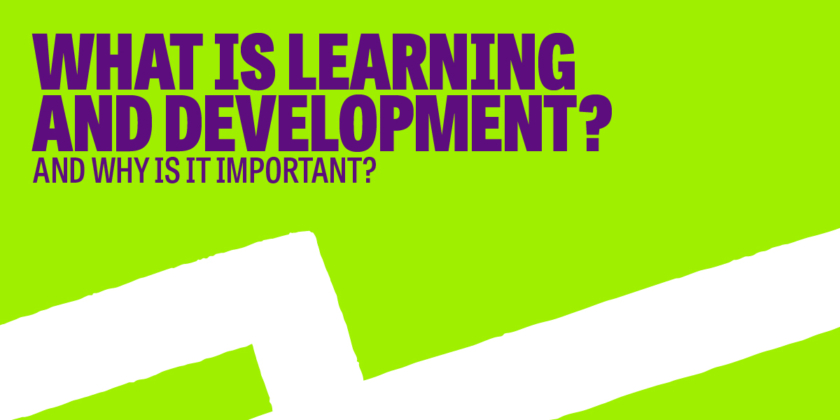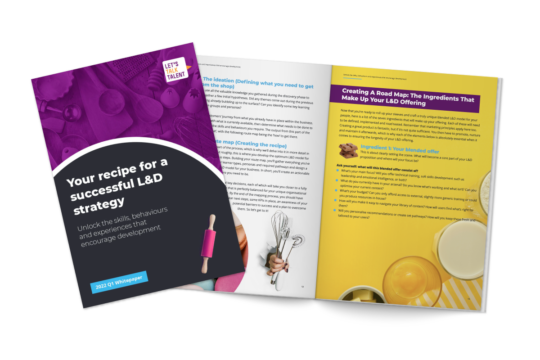Using learning and development to reach your business goals
We all know Learning and Development (L&D) is a crucial part of any HR strategy. But it’s actually more than that: it’s also a crucial part of your employee experience. It allows businesses to fill skill gaps and unlock their people’s full potential, so staff can make valuable contributions towards reaching organisational goals. It is also the kind of talent attraction and retention lever that can really give you a competitive edge, especially during a skills shortage. And we’re not talking about simply advertising L&D opportunities as a nice perk on job postings to get some initial interest.
In this article, you will learn:
- What learning and development is
- The components of a good L&D strategy
- What learning stands for in learning and development
- What development stands for in learning and development
- Why L&D matters
- Reaching your business goals through L&D
- Using learning and development to create a smooth employee experience
- How to get started with L&D
- How to implement an effective learning and development approach
In order to be effective, good L&D should underpin your entire employee experience and thus become a major factor in determining whether someone wants to come work (or stay) with you. Companies that do not offer the kind of L&D opportunities that facilitate and accelerate their employees’ career progression risk not having the right people in place to get the right things done.
So how do you go about putting all the pieces together to create a competitive L&D offering that will both help you achieve your long-term business goals and generate staff motivation? As Jo Taylor, MD at Let’s Talk Talent, says: “It’s not like Field of Dreams. If you build it, they won’t just come. You need to implement an omnichannel approach with the right resources and pathways in place to enable your people to take charge of developing their careers with you.” Here’s how to do just that.
What is learning and development (L&D)?
L&D isn’t just a generic concept. It is made up of several components, which when combined create a perfectly balanced formula for talent attraction and retention:
- 70% is done on the job (development)
- 10% is done through formal courses and resources (learning)
- 20% is about building an effective network
The components of a good learning and development (L&D) strategy
What learning stands for in L&D
The learning part of the equation is all about the acquisition of new skills, knowledge and expertise. It is often done through formal training, but do remember that learning only represents 10% of the total equation. Do not focus all of your efforts here, as other L&D initiatives need to be included in your approach.
It’s also not so much about the number of courses available as part of your offering either, but rather how you create, curate and organise those into manageable career pathways for your people. “We have a saying here at Let’s Talk Talent. We like to talk about resources, not courses,” says Jo. So go ahead and build a strong catalogue of materials made up of a variety of formats and channels, but make sure you help learners find their way and understand where to start in order to generate the most value, both for themselves and the organisation.
What development stands for in L&D
Developmen,t on the other hand, is what we call ‘on the job’ training and is a much more organic way to progress within a role, a team or an organisation. It’s about digging deeper in order to perform at a higher level, whether this is by improving upon current expertise or putting a particular skill, behaviour or attribute into practice. There are ways to accelerate development, such as coaching and mentoring, or even job shadowing, and some members of your team may be able to grow and perfect their own leadership skill set by becoming mentors or coaches themselves.
Networking is the remaining 20% of the equation and constitutes a part of L&D that shouldn’t be neglected. Building a strong, solid network of people across the organisation (and outside of it) can help employees gain a better understanding of the business and its different units, as well as introduce them to some fresh thinking and new perspectives.
Why learning and development (L&D) matters?
Reaching your business goals through L&D
As mentioned, your L&D offering isn’t just a nice perk. As a tool to unlock your people’s potential and to create a culture of high performance, it should be an intrinsic part of your cultural DNA. L&D is what will allow you to reach your business goals: by giving your people everything they need to be the best that they can be and contribute meaningfully to your organisation.
As such, your L&D strategy should be developed with your main goal in mind. What are you trying to achieve and which skills will you need to acquire as a business to get there? The answer to these questions should help you link your training needs to your business goals. For example, your objectives could dictate that your L&D focus should be on:
- Technical skills
- Mandatory requirements
- Leadership skills
- Behavioural skills
Learning and Development enables people to know where they are and the skills and expertise they require to perform well. It naturally leads to the fostering of a growth mindset and enables staff to push through their current ceiling to fully unlock their potential.
Using learning and development to create a consistent employee experience
Your L&D approach will be a constant link between each of your employee experience’s touchpoints, starting from the moment potential recruits hear about you, until the day an employee leaves the business. It will be part of your Employer Value Proposition (EVP) and influence whether someone could be interested in you as an employer. It will be critical to the onboarding stage whilst you get new staff up to speed, and be the foundation of your people’s career progression during their time with you. Your people’s learning needs may fluctuate during this lifespan, but the need for training and development will remain a constant.
What you offer in terms of L&D opportunities will also be an important component of your employees’ benefits proposition, and will be assessed as part of your total rewards package. Salary alone is no longer enough to entice and retain the best talent, and today’s modern learners require the kind of omnichannel proposition that will allow them to learn in their own time.
Getting started with learning and development (L&D)
Some smaller teams or organisations may not have huge budgets or resources, but there are always ways to be creative and offer the kind of training that will get your people motivated to learn. Whether your strategy is focused on a few high potential candidates, or everyone in your talent pool, find out what works best for your people. Have a look at the free training available, get some e-learning platforms’ licences, utilise user-generated content, create content internally or use a mix of these options to ensure there is plenty of variety to cover the right skills, for the right people, in the right format.
An effective approach to L&D
L&D will be an instrumental factor in helping you reach your business goals. But don’t forget that it’s not all about you: you do need to consider what your people want and need too. “For L&D to work as an attraction and retention lever, it’s key to talk to your people’s hands and hearts at the same time,” says Jo. So make sure you give them the tools they need to succeed at work, in a way that suits them and generates motivation and high energy. This balance can sometimes be hard to reach, granted.
And whether you’re generating training courses, setting up coaching or mentoring development programmes, or finding ways to expand your people’s networks, don’t forget to both promote and measure your efforts. Get creative, find out what works, innovate, course correct and test new things out for the perfect L&D offering for your very own organisational context.
If you’d like some help and advice as you’re planning the next iteration of your L&D strategy, don’t hesitate to book a call with us. Or have a look at our free resources on the L&D strategy service page of our website.
Download our whitepaper to find out more about how to create a perfectly blended L&D model.
Related Learning & Development Resources:
- [Free Whitepaper] Your recipe for a successful L&D Strategy
- How to use virtual coaching as part of your L&D kitbag
- Make the most of Learning at Work Week
- Why Learning at Work Week should be top of your L&D priority list
- The 27 best online L&D tools
- How L&D can improve your employee experience
- 10 ways to modernise your Learning and Development strategy for the modern workforce

